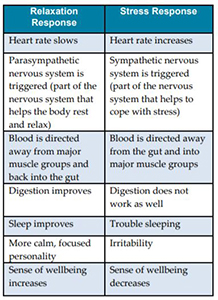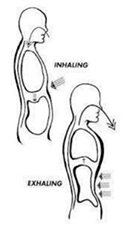Patient EducationOct | 15 | 2019
Tips to Manage Stress with the Relaxation Response
What is the Relaxation Response?
The Relaxation Response is a physical state of deep relaxation in which your body releases chemicals that slow down your breathing and heart rate. This brings healthy blood back to important organs, especially the brain. The Relaxation Response works best when you practice 1-2 times a day for 15- 20 minutes at a time.
Benefits of the Relaxation Response?
- Less muscle tension and tightness
- Feel more relaxed
- Better digestion, fewer belly aches, less nausea and more normal bowel movements
- Improved mood
- Better sense of control over emotions
- Better sleep
- Clearer thinking
- Long-term resiliency (how well people adapt to challenging situations over time)
What is the stress response?
The stress response (or fight-or-flight response) is the body’s reaction to any demanding situation.
During the stress response, your body might show some or all of these signs:
- Quick, shallow breathing
- Fast heart rate
- Sweaty palms
- Muscle tension (tightness)
- Dry mouth
- Nausea (upset stomach)
- Abdominal (belly area) pain
- Diarrhea or constipation
What happens during each response?

When does stress become harmful?
Stress is a normal response to life’s demands. Stress can be helpful in the short-term while a person deals with a demand. Stress becomes a problem when life’s demands outweigh a person’s ability to cope.
If a person is stressed for long periods of time, the body works overtime by using more oxygen. The byproducts (what is left after the cell uses oxygen) released by the cells into the body are unhealthy, leading to symptoms such as headaches, muscle tightness, sleep issues, mood changes and upset stomach.
Ways to practice the Relaxation Response
Body Awareness Exercise
This exercise can help you become more aware of how you feel during times of stress. It can also help loosen tight muscles caused by stress.
- Clench your fist. Hold it as tight as you can. Count to 20. Then, notice your breath. Are you holding it?
- Release your fist and take a deep breath.
- Make a fist again. Count to 20.
- Start to take slow, relaxed breaths. You will notice your fist start to relax when you exhale.
Simple Breath Awareness

This is an exercise in deep belly breathing. Deep belly breathes stretch muscle fibers, which then help the body and mind relax.
- Sit upright in a comfortable chair or lay flat on your back on another comfortable surface.
- Take a deep breath in. Let the deep breath completely fill your belly and ribs.
- Breathe out slowly to release the deep breath in.
- Repeat these deep breaths as many times as you would like.
- Close your eyes. Bring your attention to your breath. Is your breath long or short? Are your inhales and exhales the same length? There is no right or wrong answer. Simply notice how you are breathing.
- Place your hand on your belly. Take another deep breath in and out. Notice your belly rising and falling with each breath.
- Continue to focus on your breathing. If you notice your mind wandering away from the breath, it is okay. Bring your attention back to your breath as needed.
- When you feel ready, open your eyes. Let your focus come back to your surroundings.
Single-Pointed Focus Meditation
Meditation is one way to quiet the mind and bring on the Relaxation Response. There are many ways to meditate. Single-Pointed Focus Meditation is one way.
- Sit upright in a comfortable seat and in a quiet environment. Deeply breathe in and out.
- Repeat a single positive word or simple phrase to yourself in your head. (For example, “love”, “peace”, or “I am love.”)
- Repeat for 15-20 minutes, deepening your relaxation with each breath.
Rev. 5/2019. Information courtesy of the Benson-Henry Institute for Mind Body Medicine at Massachusetts General Hospital. Mass General for Children and Massachusetts General Hospital do not endorse any of the brands listed on this handout. This handout is intended to provide health information so that you can be better informed. It is not a substitute for medical advice and should not be used to treatment of any medical conditions.
Related Pages
Type
Patient Resources
Patient Resources for Pediatric Gastroenterology and Nutrition
Appointments and Referrals
Request an appointment or second opinion, refer a patient, find a doctor or view test results with MGfC's secure online services.

